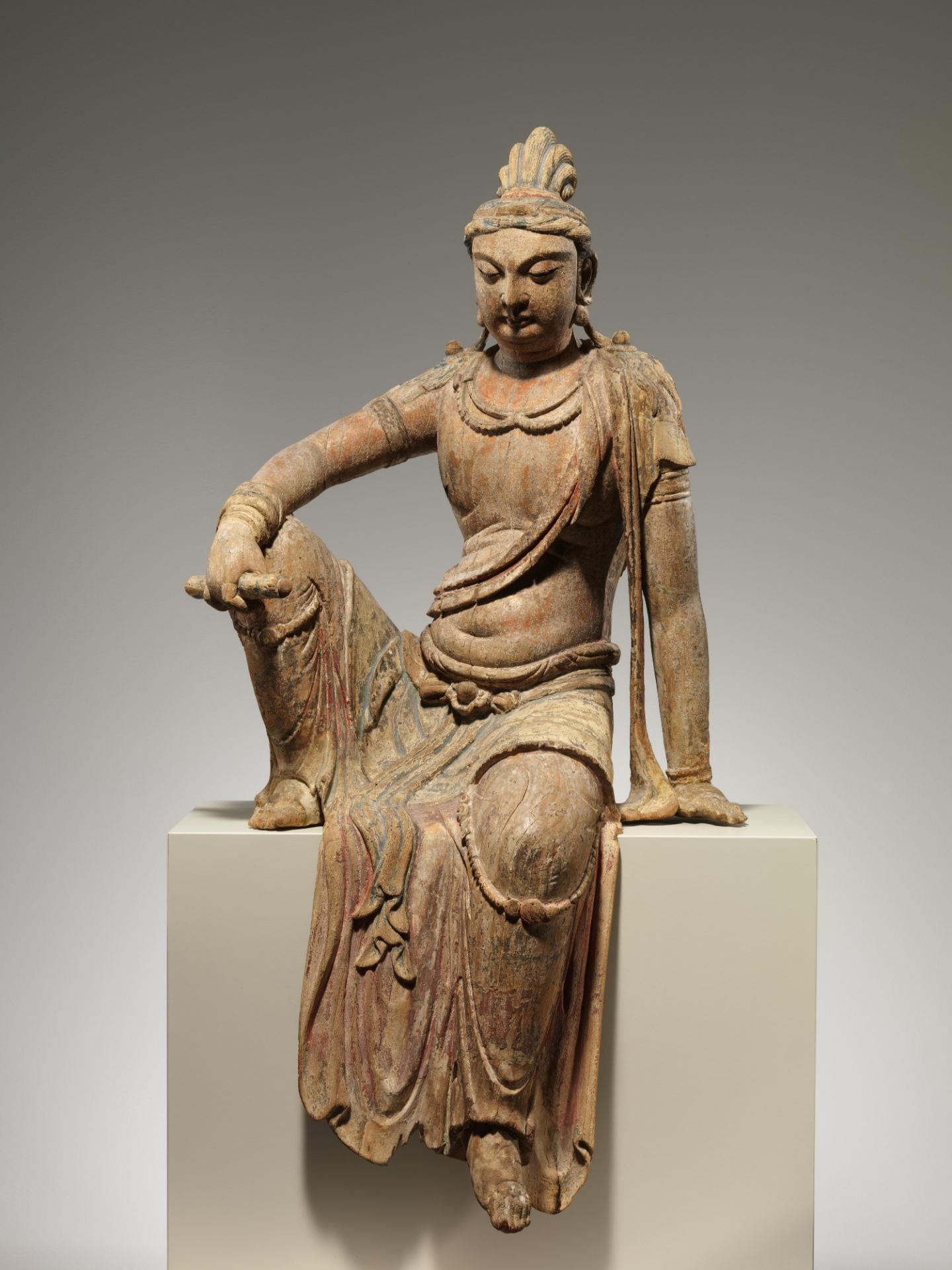*China, Bodhisattva Manjushri (Wenshu), late 10th-early 12th c., (acc. no. 42.25.5),
Date: Northern Song Dynasty (960-1127)
Culture: China
Classification: Sculpture
Size: H. 43 in. (109.2 cm); W. 23 in. (58.4 cm)
Medium: Wood (foxglove) with traces of pigment; single woodblock construction
Gift From Abby Aldrich Rockefeller, 1942
The bodhisattva is identified as Manjushri, the exemplar of spiritual wisdom. This conclusion is accepted by the fact that such figures are shown holding a scroll, a text in the form of either Chinese-style or an Indian-style palm-leaf manuscript.
The wooden sculpture, created in the late 10th to early 12th century Bodhisattva Manjushri (Wenshu) can be found the Chinese Buddhist Art Galleries located within the Metropolitan Museum of Art in the city of New York (account no. 42.25.5). Sitting at 43 inches in height and 23 inches in width, this Bodhisattva has an unknown creator. The gift given from Abby Aldrich Rockefeller in the 1940’s (museum label) identifies the bodhisattva as Manjushri, the exemplar of spiritual wisdom. This conclusion of the figure is accepted by it holding a scroll, either in the Chinese-style or an Indian-style of manuscript. Manjushri is associated with insight (prajna) within the Mahayana Buddhism culture and is identified as one of the most significant and oldest of the great bodhisattva. Compared to other Bodhisattva’s, Manjushri is portrayed in a more relaxed and casual position.
When viewing this almost life-sized sculpture in person, it is seen in yellow and brown colors, mellowed wood tones. Being almost a thousand years old, he has slowly decayed losing most of his original paint. In the depths of the carvings you can still notice the coral and blue paint which have faded termenlesly throughout the years. Certainly being as old as it is, this sculpture is in great condition. Besides the faded paint, there is no large damage him. However, the wood has cracked over the years, but even the strongest wood would dry and split. The paint which was produced from different minerals and vegetables, added more depth and expression to the statue. Making his robe a rich coral pigment giving it the look of a robe right off a buddhist. The Buddha first taught his beginning monks and nuns to create their robes out of “pure” cloth, scavenging cloth from cremation grounds. They would dye their robes with bark, flowers, leaves and different spices such as saffron and turmeric, giving the cloth a yellow-orange or maroon color, which can be seen on the statue.
The depth that was created throughout this free-standing sculpture, gives the light a natural highlight when it hits it. Creating organic shadows around the body and fabric within the crevasses. When the artist was establishing this piece, you can see that there was a lot of detail put in on the cloth of the robe. Each fold of fabric is assisted with extra depth to create a more realistic feel, almost as if it is actual cloth draped over a body. The “fabric” is topped with a belt which is being connected with a large bead. Around the body is differing types of jewelry such as simplistic bracelets, arm bands and a wide necklace wrapped around his collar bones. The sculptor finished the look off with a pair of long earings on the elongated earlobes and a fabric wrapped around his head. The detail that was added to the face and head is very small. Looking carefully at the top of the head, you can see the exact strands of hair. Making this sculpture once again, life like. The only contrast to the life-like detail is the way that the bodhisattva’s face is expressed. The buddha is most always shown with large ears and almond eyes. Both very prominent characteristics of the buddha.
Generally when you see a buddhist sculpture, the figure is seated with their legs crossed, hands placed in the lap or held up in a symbol such as Dhyana Mudra (absolute balance.) Most statues in a symmetrical closed composition. However, with this Bodhisattva, it has a very open composition. With the right leg up and right forearm draped on top, holding a scroll. This form is very relaxed and is known as the “wisdom” position. The Bodhisattva statues, they are much more relaxed in contrast to the original Buddha.
It is often said that Bodhisattvas worship their statues as if it is the Buddha, however, it is more as a symbol to them such as the cross for Christianity. It’s a symbol that they can face when praying, creating an uplifting mind and somewhere to focus if need be. They did not create the statues to represent the Buddha, which is a large misconception. Yet they do portray the iconography of what the ideal figure looked like. When creating this piece the artist must have been following the religion and made it for a temple, for others to pray with. Viewing this statue in a museum, it is best to image it in natural environment. Before being placed within the Metropolitan Museum, Abby Aldrich Rockefeller had possession of this piece. The family is known for having large quantities of art, so it was most likely being held with more pieces within one of her many properties. Thankfully in the year of 1942, the family donated Manjushri to the Asian Art Gallery.

